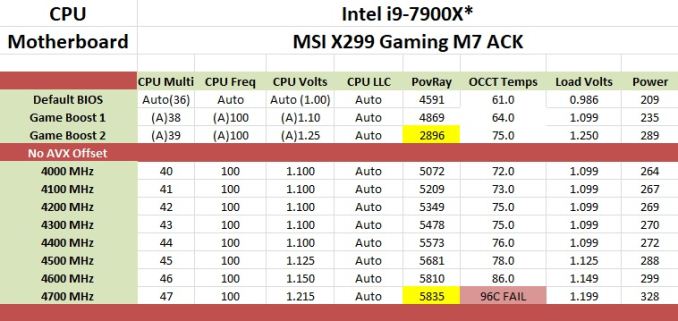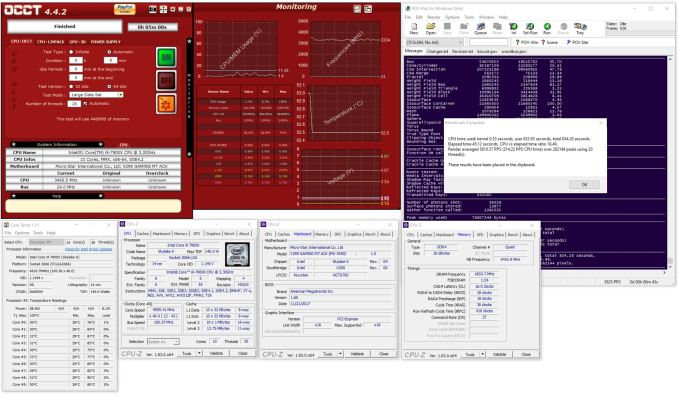The MSI X299 Gaming M7 ACK Motherboard Review: Light up the Night
by Joe Shields on March 5, 2018 10:00 AM EST- Posted in
- Motherboards
- MSI
- ATX
- M.2
- USB 3.1
- RGB
- X299
- Basin Falls
- Skylake-X
- Kaby Lake-X
- i9-7900X
Overclocking
Experience with the MSI X299 Gaming M7 ACK
Overclocking the MSI X299 Gaming M7 ACK was just as straightforward as most any other board. The BIOS options are easy to find, and most items are on the first page or one level down making finding and changing options quick and painless. The 10-phase power delivery handled up to 4.7 GHz as we blasted through the 90C temperature limit we set. Running 4.5 GHz and 1.125V, the VRMs peaked at 77.5°C in our testing environment.
The Game Boost functionality, which promises one-touch overclocking assuming the user has the right cooling, was a letdown. The knob can go up to 11, however, we were only able to use the first level. Single core limits are up to 4.4 GHz while all core AVX loads get a 200 Mhz bump to 3.8 GHz. This worked out well, but it was when we moved to level 2 where things went awry. The voltage was set to 1.25V, a huge jump, for clocks to raise 100 MHz all around (4.5 GHz single core 3.9 GHz all core AVX). We started to run POV-Ray and saw current throttling out of the gate, causing frequencies to drop, and cut results nearly in half. Manually raising the current limit to the max via Intel XTU was not successful, however disabling power limits in the BIOS allowed us to get past that hurdle. Nonetheless, the setting of 1.25V on the CPU was simply too much for this cooling to handle, and we were forced to stop there. In the end, Game Boost brought us one very minor step up from stock, leaving the other seven options unusable without a significant bump in cooling performance, delidding, or both.
The board did not run into any issues with either the DDR4-2666 or the DDR4-3200 sets of RAM we use for testing. Like the other X299 boards, it was 'set XMP and go'. We were able to overclock past the XMP settings of our 3200 sticks and reached DDR4-3600 speeds without issue as well.
The Command Center software is one of the more complete windows based utilities offering monitoring and control over the system. There are options to set up custom fan curves, the integrated GPU (not that Skylake-X has one), overclocking, and even memory (though I prefer to do so in the BIOS). It even reads and displays the MOSFET temperatures.
The MSI X299 Gaming M7 ACK is a more than capable overclocking motherboard. Game Boost needs to be tweaked to be more useful and I would have liked to see a larger heatsink on the VRM, but it has all the bells and whistles for manual overclocking and didn't flinch one bit in our testing.
Overclocking Methodology
Our standard overclocking methodology is as follows. We select the automatic overclock options and test for stability with POV-Ray and OCCT to simulate high-end workloads. These stability tests aim to catch any immediate causes for memory or CPU errors.
For manual overclocks, based on the information gathered from the previous testing, starts off at a nominal voltage and CPU multiplier, and the multiplier is increased until the stability tests are failed. The CPU voltage is increased gradually until the stability tests are passed, and the process repeated until the motherboard reduces the multiplier automatically (due to safety protocol) or the CPU temperature reaches a stupidly high level (90ºC+). Our test bed is not in a case, which should push overclocks higher with fresher (cooler) air.
Overclocking Results
The MSI X299 Gaming M7 ACK topped out at 4.6 GHz with the new processor as most others boards did before it. Due to our test bench cooling solution, we are temperature limited and without a larger custom cooler and possible delid of the CPU, we are unable to push further.
There was very little or no vdrop and vdroop with LLC set to auto. This board has voltage read points and the values listed in the table below are from the Digital Multi-Meter (and matched Core Temp, the software used to read the Vcore). All boards we have tested were very stable with voltages not needing any manual adjustment to keep load voltage close to what was set in the BIOS. At the top overclock of 4.6 GHz and 1.149V, the system pulled 299W at the wall with the CPU itself claiming a little under 200W of that value.












32 Comments
View All Comments
mkaibear - Monday, March 5, 2018 - link
>dual Realtek audio chipsHrm
>Killer based networking,
Pass
> and plenty of RGB LEDs to light up the case
Hard pass
CheapSushi - Monday, March 5, 2018 - link
Hating on Killer NICs has become a dumb meme. And guess what? The newer chips are often actual Intel. https://www.anandtech.com/show/12178/its-actually-...mkaibear - Monday, March 5, 2018 - link
I choose to "hate on them" because their USP is that they make the board somehow faster in online gaming, yet every independent test shows them to not do that - plus they increase the BOM significantly for no real benefit.The Killer chips on this board aren't Intel btw.
(There's a bit of personal history involved too - I've had several machines with Killer networking chips and they've all had significant driver problems)
nevcairiel - Tuesday, March 6, 2018 - link
Reputation is hard to fix, and if its just an Intel chip, whats the premium you get from those exactly?Personally I'll always prefer a board with plain Intel NICs, and WiFi on a PC board is meaningless to me anyway (the one you linked is Killer WiFi, not Ethernet)
Flunk - Tuesday, March 6, 2018 - link
Still a waste of money on that BoM and you get the annoying Killer app.Something being mentioned in a meme (and all memes are dumb), doesn't make it untrue.
Pork@III - Monday, March 5, 2018 - link
RGB LED give you +20 armor :D69369369 - Monday, March 5, 2018 - link
RGB LED give me erection :DPeachNCream - Monday, March 5, 2018 - link
Yet another x299 motherboard review of yet another yawn-fest RGB and Killer NIC been there and done that also ran gaming product. What's missing here is a non-standard approach and reviews up and down the product stacks of various vendors. This is what happens when you rely exclusively on what companies are willing to send you for free in the mail. They spoon feed journalists a series of gaming-class products with stupid features so we readers rarely see any decent analysis on the wider cost ranges of boards out there because poor people like Joe end up wasting their time messing with boards that only a small number of people purchase. The same thing happens with phones, processors, GPUs, and so forth.I'm sorry if this sounds rude, but it's frustrating and makes this Peach not overly fond of tech journalism at large. Add that to the years of touting Rivet Networks Killer products without ever justifying it with a benchmark or two that demonstrates there's a reason for the boosting writers have to do and it the whole site feels disappointing even if there's value in other articles. I mean there's not even a networking benchmark at all so we can't even infer added value by comparing a Killer whatever to vanilla Intel using results elsewhere. If the opening shots of the article are going to cite networking connectivity, why isn't that given even a cursory examination in the subsequent pages? What's going on Anandtech?
Ian Cutress - Monday, March 5, 2018 - link
Networking is extremely hard to get right as a test. It's easy to run it at peak speeds, but networks are rarely used in that instance.As for the marked benefit of Killer, it comes down to something not overly benchmarkable: online performance with concurrent data streams. If you are gaming, plus downloading, plus streaming, plus watching youtube on another monitor etc, the priority thing does its job. Most solutions are purely software-based - Killer's stuff is actually in hardware: for what isn't whitelisted, the packet analytics can work to decipher what sort of data is coming through, and from where: video, audio, direct downloads, torrents, and such all have detectable ways that the packet data is processed. Different codecs can have different packet profiles, and the Killer stuff is designed to detect them and adjust the return priority as appropriate. A packet will get tagged with a priority and sit in the incoming/outgoing queues, sometimes bypassing the queue altogether. Without deep networking knowledge, and hooks into the Killer hardware requirements, this is super difficult to benchmark. Unless you want a non-repeatable test with an uninterpretable result, or a repeatable test with no real-world value.
I'd love to get some proper Killer testing in, combined with an interview with the CEO and CTO. I can just tell from the comments that it would be a piece that people come just to comment negatively, rather than read, because of the Killer experience in the past. It's a topic I've discussed with the Killer team on numerous occasions.
As for the glut of X299 reviews, we have different reviewers for each chipset/socket: Joe on X299/Z370, Gavin on AM4, Tracy on TR4. Tracy has been waylayed due to lack of hardware, Gavin is new so getting up to speed, and Joe is powering through. Joe is only just moving to Z370 as well, and has a few of those already half-done.
timecop1818 - Monday, March 5, 2018 - link
> I'd love to get some proper Killer testing in, combined with an interview with the CEO and CTO.Why not actually do that? I would come to read it and laugh at the graphs showing killer not excelling at anything in particular.
I guess the reason there's not a killer nic review out there is because it would show how embarrassingly stupid the whole thing is, providing zero advantage at additional cost and actually making things worse by shitty drivers. I don't buy that QoS bullshit, Ian, you're not stupid, if some idiot is shittorenting on ADSL no amount of qos/killer is gonna make a difference when upstream is saturated. Most "gamers" that this is targeted at will either have appropriate broadband connection or be smart enough not to use bandwidth during their gaming sessions. Also with things like NAS etc having torrent/etc clients I just don't see many people using their primary gaming rig for downloading crap (or using shittorrent at all, i know i haven't for years).
I was looking at buying new XPS13 from Dell, saw it had soldered (not socket) killer WiFi, passed it for another brand.